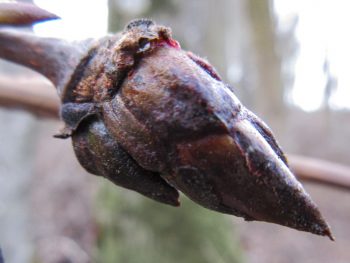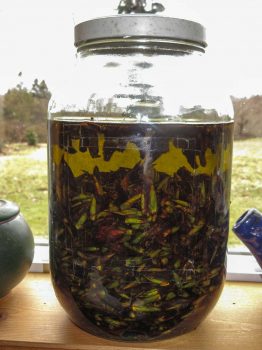Common Name: Black Cottonwood / Cottonwood

Scientific Name: Populus trichocarpa; Populus balsamifera
Family: Salicaceae
Size (H x W): 60-200 ft high; 2-5 ft. diameter – tallest among the poplar varieties
Zone: 3-9
Requirements: Sun, Soil, Water: Likes to live along stream banks and in wet areas; river soil, damp/wet conditions; full sun
Description:
It is easy to spot the Black Cottonwood, growing in tall clusters along the riverbeds. Its trunk is deeply furrowed, the leaves are alternate and shaped like a heart, the flowers are male and female catkins that form seeds that burst into fluff and fill the air with a springtime snow. Are people truly allergic to this wondrous healing tree? Or is it that it blooms at the same time as plants that are true allergins? The buds in late winter/early spring are thick with a sticky strong-scented balsamic resin, commonly known as the Balm of Gilead (but that from biblical times actually refers to a different plant). Regardless, once you smell the cottonwood resin, you will always remember it. It smells a bit like bee propolis, and indeed, the bees use it to make this antimicrobial bee medicine and also use it as a glue for their hives. They know good stuff when they see it.

Harvest: The best time to harvest the buds is in late winter – typically in January/February – if you wait too long, the buds turn into catkins. I have been told you do not have to wait for the buds to start to swell, that the medicine is in the bud, regardless, but I think if you give the bud a little squeeze and you see the sap, you know it is prime time. If it is a warm day, the resin will be more sticky, so it is good to gather when it is cold. The cottonwood branches are quite brittle and easily break during a strong wind, so the best time to collect is after a storm passes through and the branches are on the ground. Otherwise, the tree is so tall, the branches are far too high up – and, well, it is best to leave live branches for the tree, anyway. I have found that the buds are still good even from those branches that have broken off earlier in the year. In fact, it is like the buds can still gather energy from the branch, because as it gets closer to spring, even the buds on downed branches will start to swell. They are a gift. Take them. Give thanks.
Uses: Reforestation, ripairan area restoration, windbreaks, cover for birds, habitat; it is often used to control flooding. Many medicinal uses.

Medicinal: A salve or oil made from the buds is good for healing all kinds of skin irritations (eczema, rashes, burns, insect bites, dry chapped skin, sunburn, diaper rash, athletes foot, etc.). It is anti-inflammatory and great for aching muscles, bruises, and arthritis. The antimicrobial properties make it ideal for healing infections.
The buds, which are high in antioxidants and Vitamin C, can be steeped in a tea for respiratory congestion, tossed in soups, or eaten raw. I would think it would be quite bitter, but it is good to know that it is edible and healthy for you. Because some of the medicinal properties are not water-soluble, they might be better extracted with a tincture, which can be used as an expectorant and for getting rid of coughs and colds. The buds also contain salicin and populin, compounds that reduce pain, inflammation, and fevers. The resin is also known to promote cell growth, making it good for healing wounds. Feral Botanicals uses a mixture of cottonwood bud, elecampane, and mullein for dry, persistent coughs, which makes a lot of sense. Visit their website for a lot of great information on the medicinal uses of this tree.
Other active compounds include humulene, gallic acid, malic acid, mannitol, chrysin, tectochrysin, arachidonic acid, trichocarpin, and bisabolol.
Cautionary Note: Those allergic to aspirin should not consume the cottonwood (as well as willow, related poplar species, and feverfew) because it contains the same compound. Those with chicken pox or who are on blood thinners should also avoid it for the same reason.
Extra buds can be dried or frozen (freezing is best).
Recipe: Cottonwood “Balm of Gilead” Salve
Fill a jar half full of buds, cover with olive oil plus a bit more, but not to the top, as the buds will expand a bit and the jar will overflow if it is too full. Let it sit from 6 weeks to a year or more. One could also gently heat the buds and oil in a double boiler for an hour or so and then let it steep overnight, but the longer soak is preferable. Strain the oil through a cheesecloth. To make a soft salve, melt 1 ½ to 2 tablespoons (1 oz) of beeswax and add 1 cup of oil. More beeswax (2 ounces, or ¼ cup) will make a firmer, lotion “bar.” It is handy to have a small container wherever you are most likely to use it – in the medicine cabinet, first aid kit, in your car, purse, with your gardening things, etc.
Recipe: Cottonwood Tincture
The resin in the cottonwood buds is not water soluble, so if not using oil, another way to extract the medicinal properties is through a high-proof grain alcohol. Put 1 parts cottonwood buds in a jar and pour 3 parts alcohol over the top. Tightly seal and let the buds steep until the liquid turns a reddish color, which can vary depending on the kind of alcohol and the quality of the plants. Strain, bottle, label, and store in a cool dark place. Can be taken by the dropperful diluted in a glass of water several times per day.
Additional Notes:
Native tribes revered the Black Cottonwood, found all along the northwest coast and extending inland. They used the resin to waterproof baskets, and anyone who has picked the sticky buds and had the black resin all over their fingers knows how effective it can be!
I have often made a rooting hormone from willows, but did not realize that the Black Cottonwood ALSO contains natural rooting hormones that can increase the rooting success of cuttings. Prepare it the same way as with the willows: cut small stems (not leaves) into small pieces; cover with boiling water; steep overnight. I usually steep mine longer. Soak your cuttings for a couple of hours before planting. Water your tender seedlings with the water. It is both antifungal / antibacterial and a rooting stimulant.
Black Cottonwood and Bees: Another great reason to love Black Cottonwoods: the bees love them! They, too, collect the resin to make propolis, which is used to seal the hive and is used as a food source. Because it is so antibacterial, I think of it as “bee medicine.”
Resources:
Herbs with Rosalee: Cottonwood Benefits
Pojar, J. and A. MacKinnon. 1994. Plants of the Pacific Northwest Coast, Washington, Oregon, British Columbia, & Alaska. Lone Pine Publishing, Vancouver, BC, Canada.
Feral Botanicals
Radical Botany. “Black Cottonwood and the Balm of Gilead (Populus balsamifer ssp. Trichocarpa)”
Ryan Drum, Island Herbs, “Two Buds and a Leaf: Poplar Buds, Grindelia Buds, and Fig Leaves.”
Disclaimer: I am obviously not a medical practitioner. I just like to share what I learn. Also, the link to the book, “Plants of the Pacific Northwest Coast” is an affiliate link through Amazon. If you click on it and buy it, it won’t cost you any more, but I will get a little kickback for the advertising (thank you for your support!). But aside from that, I just have to say this is one of my favorite plant ID books. I take it with me all the time on hikes. Plants are indexed in a way that makes them easy to find, and I appreciate how the authors have included information on indigenous peoples’ uses of various plants, along with many other interesting tidbits that help you to feel the personality of each plant. Highly recommended.